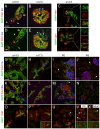A BAC transgenic Hes1-EGFP reporter reveals novel expression domains in mouse embryos
- PMID: 21745596
- PMCID: PMC3163761
- DOI: 10.1016/j.gep.2011.06.004
A BAC transgenic Hes1-EGFP reporter reveals novel expression domains in mouse embryos
Abstract
Expression of the basic helix-loop-helix factor Hairy and Enhancer of Split-1 (Hes1) is required for normal development of a number of tissues during embryonic development. Depending on context, Hes1 may act as a Notch signalling effector which promotes the undifferentiated and proliferative state of progenitor cells, but increasing evidence also points to Notch independent regulation of Hes1 expression. Here we use high resolution confocal scanning of EGFP in a novel BAC transgenic mouse reporter line, Tg(Hes1-EGFP)(1Hri), to analyse Hes1 expression from embryonic day 7.0 (e7.0). Our data recapitulates some previous observations on Hes1 expression and suggests new, hitherto unrecognised expression domains including expression in the definitive endoderm at early somite stages before gut tube closure and thus preceding organogenesis. This mouse line will be a valuable tool for studies addressing the role of Hes1 in a number of different research areas including organ specification, development and regeneration.
Copyright © 2011 Elsevier B.V. All rights reserved.
Figures








Similar articles
-
Hey2 functions in parallel with Hes1 and Hes5 for mammalian auditory sensory organ development.BMC Dev Biol. 2008 Feb 26;8:20. doi: 10.1186/1471-213X-8-20. BMC Dev Biol. 2008. PMID: 18302773 Free PMC article.
-
Separate and coincident expression of Hes1 and Hes5 in the developing mouse eye.Dev Dyn. 2018 Jan;247(1):212-221. doi: 10.1002/dvdy.24542. Epub 2017 Aug 2. Dev Dyn. 2018. PMID: 28675662 Free PMC article.
-
Rhythmic gene expression in somite formation and neural development.Mol Cells. 2009 May 31;27(5):497-502. doi: 10.1007/s10059-009-0068-1. Epub 2009 May 15. Mol Cells. 2009. PMID: 19466597 Review.
-
Ectopic pancreas formation in Hes1 -knockout mice reveals plasticity of endodermal progenitors of the gut, bile duct, and pancreas.J Clin Invest. 2006 Jun;116(6):1484-93. doi: 10.1172/JCI27704. Epub 2006 May 18. J Clin Invest. 2006. PMID: 16710472 Free PMC article.
-
Expression dynamics and functions of Hes factors in development and diseases.Curr Top Dev Biol. 2014;110:263-83. doi: 10.1016/B978-0-12-405943-6.00007-5. Curr Top Dev Biol. 2014. PMID: 25248479 Review.
Cited by
-
Ptf1a-mediated control of Dll1 reveals an alternative to the lateral inhibition mechanism.Development. 2012 Jan;139(1):33-45. doi: 10.1242/dev.071761. Epub 2011 Nov 17. Development. 2012. PMID: 22096075 Free PMC article.
-
Strength of interactions in the Notch gene regulatory network determines patterning and fate in the notochord.Elife. 2022 Jun 6;11:e75429. doi: 10.7554/eLife.75429. Elife. 2022. PMID: 35658971 Free PMC article.
-
Stochastic priming and spatial cues orchestrate heterogeneous clonal contribution to mouse pancreas organogenesis.Nat Commun. 2017 Sep 19;8(1):605. doi: 10.1038/s41467-017-00258-4. Nat Commun. 2017. PMID: 28928395 Free PMC article.
-
Dynamic cell contacts between periportal mesenchyme and ductal epithelium act as a rheostat for liver cell proliferation.Cell Stem Cell. 2021 Nov 4;28(11):1907-1921.e8. doi: 10.1016/j.stem.2021.07.002. Epub 2021 Aug 2. Cell Stem Cell. 2021. PMID: 34343491 Free PMC article.
-
LINC MIR503HG Controls SC-β Cell Differentiation and Insulin Production by Targeting CDH1 and HES1.Adv Sci (Weinh). 2024 Apr;11(13):e2305631. doi: 10.1002/advs.202305631. Epub 2024 Jan 20. Adv Sci (Weinh). 2024. PMID: 38243869 Free PMC article.
References
-
- Ahnfelt-Ronne J, Jorgensen MC, Hald J, Madsen OD, Serup P, Hecksher-Sorensen J. An improved method for three-dimensional reconstruction of protein expression patterns in intact mouse and chicken embryos and organs. J Histochem Cytochem. 2007;55:925–930. - PubMed
-
- Apelqvist A, Li H, Sommer L, Beatus P, Anderson DJ, Honjo T, Hrabe de Angelis M, Lendahl U, Edlund H. Notch signalling controls pancreatic cell differentiation. Nature. 1999;400:877–881. - PubMed
-
- Burke Z, Oliver G. Prox1 is an early specific marker for the developing liver and pancreas in the mammalian foregut endoderm. Mech Dev. 2002;118:147–155. - PubMed
-
- Chen L, Al-Awqati Q. Segmental expression of Notch and Hairy genes in nephrogenesis. Am J Physiol Renal Physiol. 2005;288:F939–952. - PubMed
Publication types
MeSH terms
Substances
Grants and funding
LinkOut - more resources
Full Text Sources
Molecular Biology Databases
Miscellaneous

